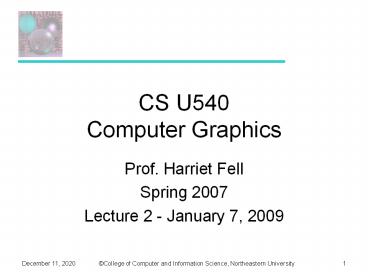CS U540 Computer Graphics - PowerPoint PPT Presentation
Title:
CS U540 Computer Graphics
Description:
4 College of Computer and Information Science, Northeastern University. Early TV. 5 ... Jurassic Park III, Pearl Harbor,ILM. Planet of the Apes, Asylum ... – PowerPoint PPT presentation
Number of Views:131
Avg rating:3.0/5.0
Title: CS U540 Computer Graphics
1
CS U540Computer Graphics
- Prof. Harriet Fell
- Spring 2007
- Lecture 2 - January 7, 2009
2
Early History
- http//accad.osu.edu/waynec/history/timeline.html
- 1801 Joseph-Marie Jacquard invented an automatic
loom using punched cards to control patterns in
the fabrics. The introduction of these looms
caused the riots against the replacement of
people by machines. - 1941 First U.S. regular TV broadcast,
- 1st TV commercial (for Bulova
watches) - 1948 Transistors
- 1949 Williams tube (CRT storage tube)
3
Jacquard Loom
From Wikipedia.org
4
Early TV
5
History the 50s
- 1951 Graphics display, Whirlwind computer
- 1954 color TV
- 1955 Light Pen, SAGE- Lincoln Lab
- 1958 Graphics Console, TX-1 MIT
- 1958 John Whitney Sr. uses analog
- computer to make art
6
1951 Graphics display, Whirlwind computer
7
SAGE
8
John Whitney Sr. 1958 CG
Vertigo Start Titles
9
History - the 60s
- 1961 Spacewars, 1st video game, Steve Russell,
MIT for PDP-1 - 1963 Sketchpad, Ivan Sutherland, MIT
- 1963 Mouse invented, Doug Englebart, SRI
- 1963 Roberts hidden line algorithm, MIT
- 1965 Bresenham Algorithm for plotting lines, IBM
- 1966 Odyssey, home video game, Ralph Baer,
- Sanders Assoc, is 1st consumer CG product
- 1967 Full-color, real-time, interactive
- flight simulator for NASA - Rod
Rougelet, GE
10
Spacewars
11
Ivan Sutherland Sketchpad System on TX-2 at
MIT(1963)
12
Odyssey
http//www.geekcomix.com/vgh/first/odyssey.shtml
13
Roberts Hidden Line AlgorithmBlock scene (576
blocks)
14
Bresenham Line Algorithm
15
History the 70s
- 1970s Utah dominated - algorithm development
- 1970 Watkins algorithm for visible surfaces
- 1970 Bezier free-form curve representation
- 1971 Gouraud shading
- 1973 Principles of Interactive Computer Graphics
(Newman and Sproull) - 1974 Addressable cursor in a graphics display
terminal - DEC VT52 - 1974 z-buffer developed by Ed Catmull (Univ of
Utah) - 1975 Phong shading
- 1975 Fractals - Benoit Mandelbrot (IBM)
- 1978 Bump mapping, Blinn
- 1979 George Lucas starts Lucasfilm
- with Ed Catmull, Ralph Guggenheim, and Alvy Ray
Smith
16
Watkins Scan-Line Algorithm
17
Bezier Curves
18
Gouraud Shading
http//freespace.virgin.net/hugo.elias/graphics/x_
polygo.htm
19
Phong Shading
20
Fractals
21
Bump Map
Bump Maps in PovRay
22
History - the 80s
- 1980s Cheaper machines, memory - quest for
realsim - 1980 Ray Tracing, Turner Whitted, Bell Labs
- 1981 IBM introduces the first IBM PC (16 bit
8088 chip) - 1982 Data Glove, Atari
- 1984 Macintosh computer
- introduced with Clio award winning commercial
during Super Bowl - 1985 Perlin Noise
- 1986 GIF format (CompuServe)
- 1988 Who Framed Roger Rabbit live action
animation
23
Whitted Ray-Tracing
http//en.wikipedia.org/wiki/Ray_tracing
24
Perlin Noise
25
Who Framed Roger Rabbit
26
History- the 90s
- 1990s Visualization, Multimedia, the Net
- 1991 JPEG/MPEG
- 1993 Myst, Cyan
- 1994 U.S. Patent to Pixar
- for creating, manipulating and displaying images
- 1995 Toy Story, Pixar
- 1995 Internet 2 unveiled
- 1997 DVD technology unveiled
- 1998 XML standard
- 1999 deaths
27
Myst
28
Toy Story
29
Recent History
- 2000s Virtual Reality, Animation Reality
- 2001 Significant Movies
- Final Fantasy, Square)
- Monsters Inc, Pixar
- Harry Potter, A.I., Lord of the Rings, Shrek, PDI
- The Mummy, ILM
- Tomb Raider, Cinesite
- Jurassic Park III, Pearl Harbor,ILM
- Planet of the Apes, Asylum
- 2001 Microsoft xBox and Nintendo Gamecube
- 2001, 2002, 2003 Lord of the Rings
30
from Lord of the Rings
- Motion Capture Technology
- Andy Serkis "played" Gollum by providing his
voice and movements on set, as well as performing
within a motion capture suit. - SKIN
- Christoper Hery, Ken McGaugh and Joe Letteri
received a 2003 Academy Award, Scientific or
Technical for implementing the BSSRDF
(Bidirectional Surface Scattering Reflection
Distribution Function) technique used for
Gollum's skin in a production environment. Henrik
Wann Jensen, Stephen Robert Marschner, and Pat
Hanrahan, who developed BSSRDF, won another the
same year. - MASSIVE
- a computer program developed by WETA to create
automatic battle sequences rather than
individually animate every soldier. Stephen
Regelous developed the system in 1996, originally
to create crowd scenes in King Kong.































